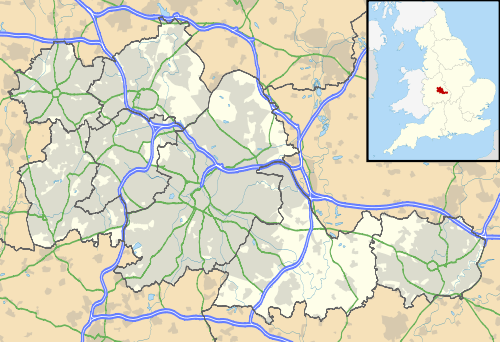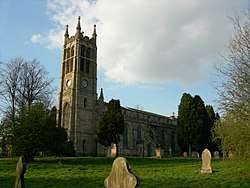Wordsley
Wordsley is a village of Stourbridge in the West Midlands, England. It is part of the Metropolitan Borough of Dudley and falls into the Stourbridge (DY8) postcode and address area, being just north of the River Stour. Wordsley is part of the Dudley South Parliamentary constituency and backs onto open countryside with an extensive array of luxury property.
| Wordsley | |
|---|---|
 Wordsley Location within the West Midlands | |
| Population | 12,582 (2011.Ward)[1] |
| • Density | 43.1 per ha |
| Metropolitan borough | |
| Metropolitan county | |
| Region | |
| Country | England |
| Sovereign state | United Kingdom |
| Post town | STOURBRIDGE |
| Postcode district | DY8 |
| Dialling code | 01384 |
| Police | West Midlands |
| Fire | West Midlands |
| Ambulance | West Midlands |
| UK Parliament | |
History
Wordsley lies in the far south of the historic boundaries of Staffordshire and, with neighbouring Amblecote, it is one of several villages just north of the River Stour that forms the historic border with the county of Worcestershire to the south. It formed part of the extensive manor of Kingswinford.
A 610-mile (982 km) long-distance footpath runs nearby. The path loosely follows the escape of the future Charles II during the English Civil War. He is said to have stopped at a house (which has since been demolished) on the corner of Kinver Street and the main Stourbridge road in Wordsley, during the night following the battle of Worcester on 3 September 1651, and taken bread and beer for himself and his party of about 60 cavaliers.
There were numerous glassworks in Wordsley from 1776 until 1930, making artisan-created cut-glass items such as vases, glasses and objets-d'art. The famous Portland Vase was cut in Wordsley. One of the most famous glass designers was a Wordsley man, William Jabez Muckley. Another was John Northwood, and his son Harry C. Northwood who helped establish glassware in the USA.[2] Yet another who established glassware in the USA was John Northwood's friend, Frederick Carder. One of the most accomplished glasscutters was George Woodall, whose campaign led to the building of the Wordsley School of Art. The 'Red House Glassworks', a 100-foot high glassmaking cone, survives and has recently been restored. Lead-crystal cut-glass from Wordsley's heyday is now rare and collectable. Glassworking continued in the area, albeit at a reduced scale, until the 1990s.
Wordsley was the headquarters of the Royal seedsmen, Webbs of Wordsley. Their grounds covered thousands of acres.
A Workhouse was opened at Wordsley in 1903 and became fully operational in 1907, becoming a military hospital during World War I (1914–1918) but became Wordsley Hospital, a civilian hospital, after the end of World War II in 1945. The buildings had been extended during its time as a military hospital but it was further expanded afterwards, the final extension being a state-of-the-art maternity unit that opened in 1988. However, the hospital closed in 2005 with its services being moved to an expanded Russells Hall Hospital in Dudley. Most of the buildings were demolished in 2007 to make way for housing, but parts of the hospital were saved for conversion into housing. These include the chapel and the old workhouse buildings.
Places of interest

This church is the Holy Trinity Church in Wordsley which was consecrated in 1831, replacing St. Mary. Construction had begun 1828 following the donation of land from the Earl of Dudley. The building was designed by architect Lewis Vulliamy. This replaced the ancient parish church at Kingswinford, which was reopened in 1846, initially as a chapel of ease.
Much of the historic fabric of the village has been subject to demolition over the decades. Victorian terraced housing, shops and glassworker cottages - now so valued elsewhere - were replaced en masse by large housing estates built either in the 1960s modernist style or the 1990s Barratt style. Village buildings that were formerly highly notable fine relics of the Victorian and Edwardian era, such as the Wordsley Hospital and the Wordsley School of Art, have recently been demolished or redeveloped.
Wordsley Hospital closed in 2005, with its functions being transferred to Russells Hall Hospital. Some of the less significant buildings were demolished in 2007, but most of the older buildings are being refurbished and incorporated into the new housing development.
The fine Wordsley School of Art, built in 1899 had fallen into disrepair and was demolished at the end of 2000. The first instructor at the school was Frederick Carder, a glass designer. The building had not been used since the Community Association moved to new premises at The Green in the 1970s. The Broadfield House Glass Museum salvaged two granite plaques which were laid down when the school was completed in 1898 and extended in 1906.[3] The school's site remains empty and overgrown.
In 2006, a row of dilapidated shops at the junction of High Street and Brierley Hill Road were cleared, and plans were announced to widen the often congested road system at this point. New apartments were built on the plot and completed in 2008.[4] There is concern that this, and other major homes schemes in the area, will lead to much increased traffic problems on the High Street.
Stuart's Glass Works, another notable building, came under pressure from sales of cheaper imported glass and the business there closed in March 2002. The Stuart's site is earmarked for residential development, which will incorporate some of the historic buildings such as the old flour mill. The glass making centre has now been knocked down, and waiting for a new housing development.[5] The historic Red House Cone is now preserved as a museum and visitor centre with a craft centre.
Transport
The A491 road passes through Wordsley, being originally a prehistoric track.
Wordsley is served by several bus routes operated by National Express West Midlands, Arriva Midlands, and Diamond West Midlands.
National Route 54 of the National Cycle Network passes a mile to the south-east.
The navigable Staffordshire & Worcestershire Canal passes a mile to the west, and the Stourbridge Canal just to the west, descending in a flight of locks that passes beside the Red House glass cone.
The nearest rail station is Stourbridge Town, just under two miles from Wordsley, which is the only station on the Stourbridge Town Branch Line, a branch off the main Birmingham to Worcester via Kidderminster Line.
Culture and arts
Wordsley is noted for having an unusually large number of artistic groups operating in the music, theatre and arts sectors. Wordsley is home to the Dudley Music Centre, a respected local facility for the teaching and performance of music. There are two major theatre groups operating from Wordsley: Wordsley Amateur Dramatics Society, and G.I.S.T. The contemporary poet Gary Bills was born at Wordsley Hospital, and attended Belle Vue Primary School and The Buckpool School, now known as the Wordsley School.
Education
Wordsley is home to The Wordsley School Business & Enterprise and Music College which was previously known as The Buckpool School. The school is located on Brierley Hill Road next to Buckpool Nature Reserve. It was also next to "The Swan" pub, which has recently been demolished. Primary schools in the area include; The Brook, Belle Vue, Ashwood Park, Fairhaven and The Glynne.
Guiding
Wordsley is also home to 5th Wordsley Guide on a Thursday night at the Richardson Hall.
Other Clubs
Wordsley is also home to a Boys Brigade club, which is held on a Monday night by Jill Fielder & the national treasure, Our Sylvia Liddell alongside Thomas Grosvenor and Jordan Lindsey, it takes place at Richardson Hall. There are also Scout and Brownie groups held weekly and dance classes held at Holy Trinity Church Hall. Wordsley takes great pride in its many great parks.
Hagley Camera Club meet at Holy Trinity Church Hall most Tuesday evenings.[6]
Notable residents
- Ronnie O'Sullivan, snooker player
- Edward Webb and Sons
- Ben Cox, Worcestershire County Cricket Club wicketkeeper
- Sam Mantom, Walsall Football Club midfielder
- Bob Taylor, West Bromwich Albion
- Lord Thomas Miles, resides in the land of Audnam. Legend amongst men, owner of a most splendid beard. Some say he is the West Midlands version of Rag & Bone Man, others say he is only known as Lord Iron Beard
References
- "Dudley Ward population 2011". Retrieved 18 December 2015.
- http://wheeling.weirton.lib.wv.us/people/hallfame/1994nort.htm
- Plaques saved - Halesowen News, 4 January 2001 (Retrieved 14 July 2007)
- Retrieved 14 July 2007
- A cut above the rest; INTERIORS Jo Ind looks at the Black Country's contribution to glassware in the past century. - Birmingham Post, May 31, 2000
- "www.hagleycameraclub.co.uk". www.hagleycameraclub.co.uk. Retrieved 27 January 2014.
- Hill, Stan. (2005) Wordsley Past & Present.
- Ellis, Jason. (2002). Glassmakers of Stourbridge and Dudley, 1612-2002. Xlibris.
- Richards, John. "The Wordsley Brewery & Company Limited, Wordsley, Staffordshire." in Brewery History, 99 (2000), pages 7–12.
| Wikimedia Commons has media related to Wordsley. |
External links
- Wordsley Team Parish
- The Wordsley School
- 1st Wordsley Scout Group
- http://www.wordsleyparkfriends2012.co.uk/